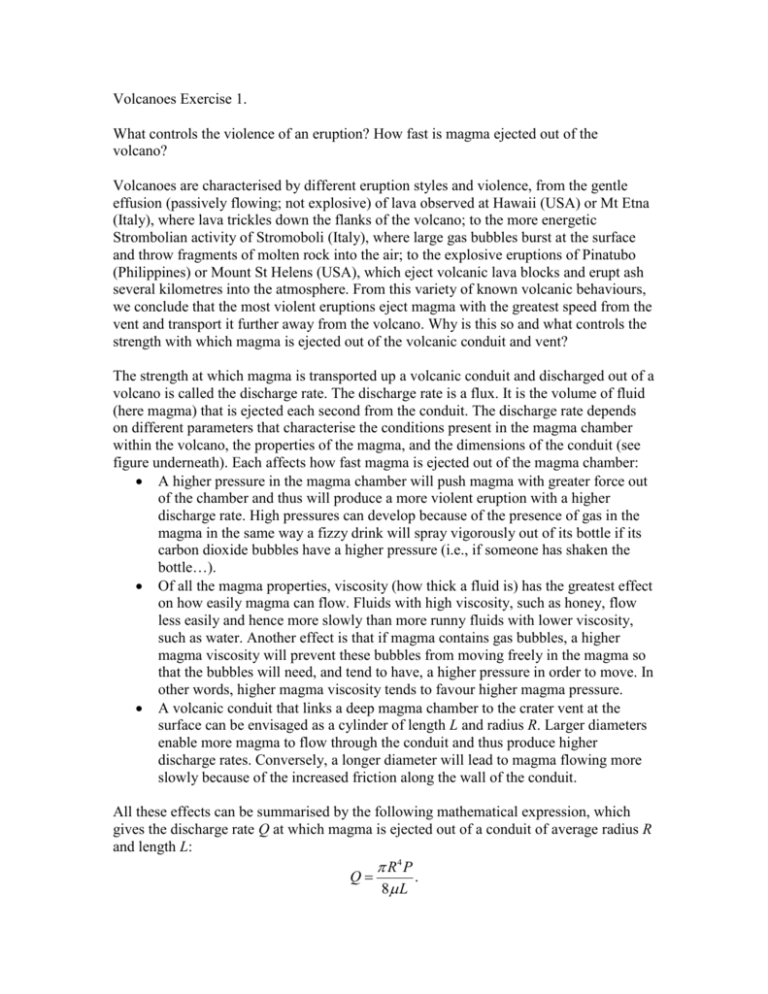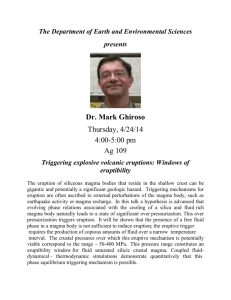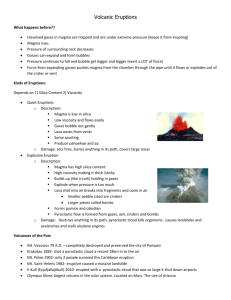What controls the violence of an eruption
advertisement

Volcanoes Exercise 1. What controls the violence of an eruption? How fast is magma ejected out of the volcano? Volcanoes are characterised by different eruption styles and violence, from the gentle effusion (passively flowing; not explosive) of lava observed at Hawaii (USA) or Mt Etna (Italy), where lava trickles down the flanks of the volcano; to the more energetic Strombolian activity of Stromoboli (Italy), where large gas bubbles burst at the surface and throw fragments of molten rock into the air; to the explosive eruptions of Pinatubo (Philippines) or Mount St Helens (USA), which eject volcanic lava blocks and erupt ash several kilometres into the atmosphere. From this variety of known volcanic behaviours, we conclude that the most violent eruptions eject magma with the greatest speed from the vent and transport it further away from the volcano. Why is this so and what controls the strength with which magma is ejected out of the volcanic conduit and vent? The strength at which magma is transported up a volcanic conduit and discharged out of a volcano is called the discharge rate. The discharge rate is a flux. It is the volume of fluid (here magma) that is ejected each second from the conduit. The discharge rate depends on different parameters that characterise the conditions present in the magma chamber within the volcano, the properties of the magma, and the dimensions of the conduit (see figure underneath). Each affects how fast magma is ejected out of the magma chamber: A higher pressure in the magma chamber will push magma with greater force out of the chamber and thus will produce a more violent eruption with a higher discharge rate. High pressures can develop because of the presence of gas in the magma in the same way a fizzy drink will spray vigorously out of its bottle if its carbon dioxide bubbles have a higher pressure (i.e., if someone has shaken the bottle…). Of all the magma properties, viscosity (how thick a fluid is) has the greatest effect on how easily magma can flow. Fluids with high viscosity, such as honey, flow less easily and hence more slowly than more runny fluids with lower viscosity, such as water. Another effect is that if magma contains gas bubbles, a higher magma viscosity will prevent these bubbles from moving freely in the magma so that the bubbles will need, and tend to have, a higher pressure in order to move. In other words, higher magma viscosity tends to favour higher magma pressure. A volcanic conduit that links a deep magma chamber to the crater vent at the surface can be envisaged as a cylinder of length L and radius R. Larger diameters enable more magma to flow through the conduit and thus produce higher discharge rates. Conversely, a longer diameter will lead to magma flowing more slowly because of the increased friction along the wall of the conduit. All these effects can be summarised by the following mathematical expression, which gives the discharge rate Q at which magma is ejected out of a conduit of average radius R and length L: R4 P Q . 8 L is the viscosity of the magma and P is the pressure inside the magma chamber. Figure: Schematic picture of a volcano with its magma chamber and conduit. The magma chamber lies at a depth L below the crater vent and is linked to the vent by a conduit of average diameter D. The pressure P inside the magma chamber pushes magma up the volcanic conduit and ejects the magma with a discharge rate Q. Exercise: If we know or measure the dimensions R (R = D/2) and L of the conduit, the pressure in the magma chamber P, and the magma viscosity at 2 different volcanoes, such as Hawaii and Mount St Helens, can we calculate how fast magma is ejected/erupted for these 2 volcanoes? Hawaii The viscosity of Hawaiian magma is quite low and has been measured in laboratories to be = 100 Pa s (Pascal second, or Pa s, is the unit of viscosity). Seismic studies have revealed that the magma chamber beneath Hawaii lies at a depth of about 5 km and it has been observed that magma erupt through vents of a couple of metres in diameter, which gives L = 5000 m and R = 1 m. Finally, studying the composition of the crystals present in the magma indicate that the pressure pushing the magma out of the magma chamber during a typical Hawaiian eruption is about 5 x106 = 5,000,000 Pa (Pascal, or Pa, is the unit of pressure). Mount St Helens The viscosity of magma erupted in May 1980 at Mount St Helens is has been measured to be = 2 106 = 2,000,000 Pa s. Seismic studies reveal that the top of the magma chamber is at about 7 km below the surface and that magma erupts through a 100 m diameter conduit: L = 7000 m and R = 50 m. The pressure pushing the magma out of the magma chamber during the May 1980 eruption has been estimated to be about 3 x 107 = 30,000,000 Pa. Calculate the eruption discharge rate for both volcanoes. Which one would be the most hazardous (and why?) and which one would be the less hazardous? Results: Hawaii L = 5 km, viscosity = 100 Pa s, D = 1 m, P=5 x 106 Pa s Q~4 m3/s Mount St Helens L = 7 km, viscosity = 2000000 Pa s, D = 100 m, P= 3 x 107 Pa s Q~5000 m3/s Main difference comes from diameter: higher value for MSH leads to higher discharge rate despite the fact that magma is more viscous at MSH than for Hawaii. Also pressure is slightly higher at MSH than it is at Hawaii. Mt St Helens would be the most hazardous volcano as the magma is ejected at much faster rates than at Hawaii.








